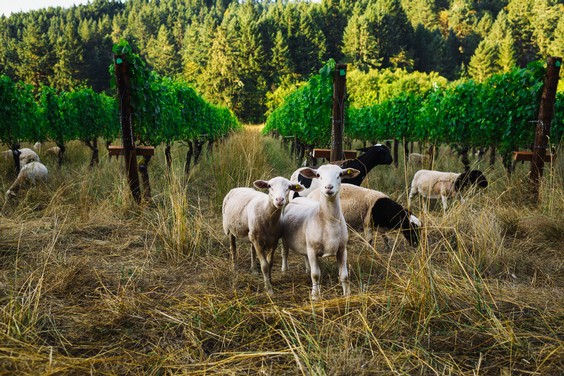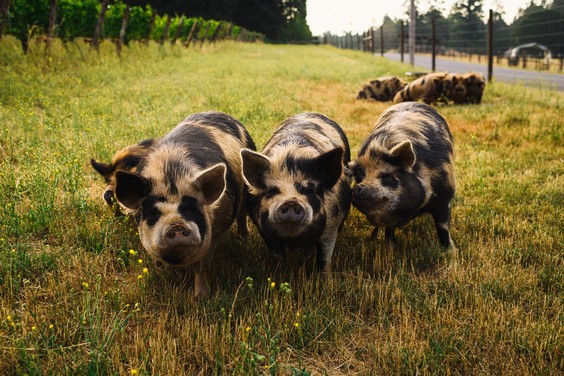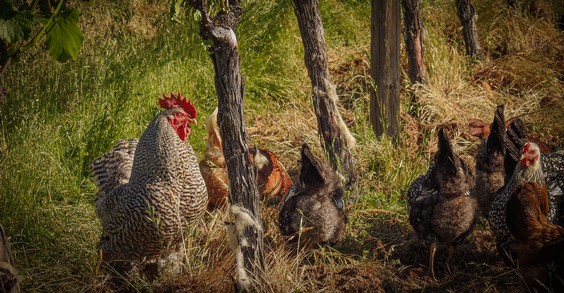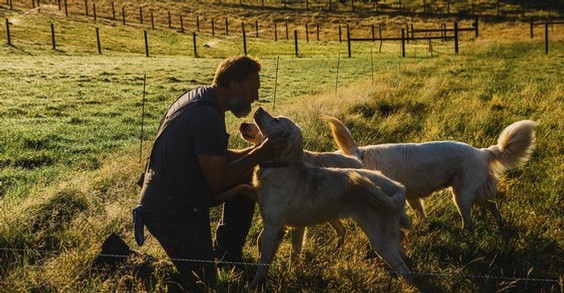Grazing-Based Viticulture
Grazing-Based Viticulture was first conceived and implemented at Antiquum Farm. The central tenet of this process is to grow wines that clearly communicate the wild and honest soul of this place and the principles of its people. Antiquum Farm is managed without fertilizers, compost, or foliar feeds in order to truly isolate our site, conserve resources, and create wines of individualistic spirit and truthful terroir. We have carefully selected animals that physically fit into the constraints of the vineyard, complement each other, and support an intricate, living, breathing ecosystem. We see our farm as a complex community where the vines are part of a whole, not the whole.
Farming in this manner is an all encompassing way of life that asks a viticulturist to become so much more than a winegrower. Producing the truest, most articulate, and expressive wines requires the vineyard to be transformed into more than a collection of vines, techniques, and methods. In doing so, the farmer creates the opportunity for something completely divergent from historical, varietal, or regional expectations. The diversity of the farm results in healthier, more resilient vines and produces wines of soulful clarity and unexpected character that are true expressions of this place and its people. Learn More.
Cast of Characters

Katahdin/Dorper Sheep
Sheep are the cornerstone of Grazing-Based Viticulture, and their activity is the engine that powers the vines. The sheep lead our grazing rotations with the pigs, performing the yeoman's work of propelling the cycle of nutrient generation in the vineyard. Their care and maintenance are extremely labor intensive. However, we believe they are the most important component of creating a self-sustaining vineyard that clearly expresses authentic terroir. Learn More.

Kune Kune Pigs
Our pigs are funny, friendly, and efficient. These beauties fit perfectly into Grazing-Based Viticulture and dovetail seamlessly with our sheep. Their enthusiastic grazing contributes greatly to vineyard floor root growth and die-off cycles with each rotation. These cycles super charge the microbial diversity and site specification that fuels the personality of our wines. Learn More.

Poultry and Fowl
Behind every great grazer is a hardworking bird. Have you watched a cow or wildebeest grazing and wondered why there are birds all around their feet? The obvious answer is the cow is disturbing insects in the soil, which the birds appreciatively snatch up. However, there is more going on than what meets they eye. Those birds are performing incredibly important services for the larger animals by reducing their pests and parasite populations. Birds are the symbiotic sanitation crew for larger grazers. Learn More.

Guardian Dogs
Our beloved dogs are the glue that holds Grazing-Based Viticulture together. Our remote location, heavy predator load, and belief that big predators are an important part of our ecosystem necessitate the presence of a 24-hour security team. We farm in order to work and live within the natural world, not to be at war with it. Livestock guardian dogs are an elegant solution that allows us to walk our talk and lambs to chew their cud at the same time. Learn More.
What Grazing-Based Viticulture Is…And Isn’t
We see organic and biodynamic certification as positive steps, but we are setting a higher bar. We have come to know organic fertilization to be an unsustainable protocol that homogenizes the personality of vineyards. Organic fertilizers come from a small set of sources and are trucked across the country in the name of sustainability. Composting likewise offers little true contribution to a sustainable methodology. I have yet to see a biodynamic vineyard build compost piles actually capable of feeding more than a couple acres. Most would barely service a large community garden. These piles are cute, symbolic marketing tools built for chest pounding at best. Moreover, building, turning, and distributing any pile of compost will always require significant machinery use.
Grazing-Based Viticulture harnesses the sun’s energy to capture and store atmospheric carbon. Repeatedly rotating animals through the vineyards prolongs our grazing window and generates the tonnage of organic material truly required to fuel our farm. The above-ground material is grazed, broken down, and redistributed to the soil – all without the use of machinery. Much of this material is carried beneath the surface by soil organisms. However, the real work is happening in the root mass where tons of atmospheric carbon are captured and a richly complex chain reaction occurs.
Our vineyard animals rotate in a choreographed dance called rotational intensive grazing. They are moved every 3 to 21 days depending on the time of year, number of animals, temperature, and rainfall. It is a constant juggle and getting it right is a combination of instinct and art. Each time the animals graze off an area, plant biomass is reduced. Because root biomass always mirrors the above-ground mass of any plant, a certain portion of the root mass dies off in correlation with the reduced needs of the plant. This root die-off initiates a very important series of reactions as an entire galaxy of mycorrhizal fungi and microbiological organisms in the soil begin to consume the material. Over time, the soil biome flourishes as the reactions are compounded across multiple rotations per year. As a result, the soil itself begins to change. This is where the magic happens.
The decaying root structures stimulate the soil biome in the absence of off-site fertilizers or compost, and these microbiological communities gradually colonize the roots of the vines and other plants. The microbes begin to break down insoluble nutrients and deliver them to the vines in a form they can utilize. The vines, in turn, begin to give back a portion of their carbohydrate reserves in the form of simple sugars to feed the microbes. Insoluble nutrients are bound up in our soils in nearly inexhaustible amounts, and this symbiotic relationship gives the vines access to a previously off-limit supply of nutrition. This is nothing short of a paradigmatic shift in the way we understand grapevine metabolism.
As the microbiological community mutated to adapt to the specific conditions of every little pocket of our vineyards, we saw dramatic, unprecedented shifts in the vines themselves. Clonal selections became completely irrelevant as wild variations emerged within the same clonal block. We witnessed a series of very obvious physical mutations – changes in fruit color, multi-colored and patterned berries, massive shifts in ripening curves, uncharacteristic skin composition, and extremes of physiological chemistry. These features come together to make wines that, in many ways, are not remotely indicative of Pinot Gris, Pinot Noir, or the Willamette Valley.
Why We Do It
We believe achieving excellence requires asking questions of ourselves and thinking critically. This shift in philosophy and practice began when, as a young newbie grower, I listened to winemakers of great experience pontificate about the concept of terroir. These conversations always led me back to asking about the farming. How do the methods and materials used in the field translate to the wines? How could they possibly be expressing terroir? Worse, weren’t we all slowly homogenizing our vineyards with these identical, prescribed input regimens? When we spoke of making wines that embody place, were we really just selling people an idea that was a shell game? For me, the answers were always disappointingly superficial and, frankly, market-driven. No one wanted to address the fact they we were all using the same materials and those materials had no intrinsic relation to region or site.
Let's just say I didn't make a lot of friends.
I got into farming because I believe agriculture has the potential to cast light on the best of humanity: inspiration, individualism, creativity, kindness, honesty, and beauty. We grow wine because we feel it embodies the most direct line from farming to art form. This is the larger mission of our work and something that inspires us to lace up our boots every day.
If you made it this far, we appreciate your interest and admire your tenacity. Thank you for taking the deep dive into Grazing-Based Viticulture. We feel privileged to be able to share the boundless joy of our farm with you. We hope you feel the love, energy, and care that go into everything we do. You are our people.
– Stephen Hagen, Owner and Farmer
Join Our Mailing List
Keep up to date on the latest wine releases and happenings at the Farm.